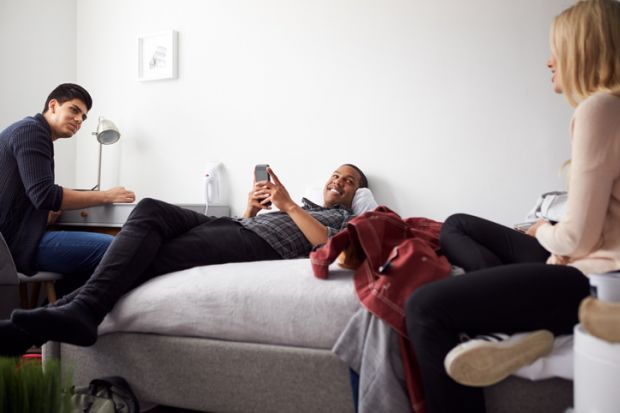I recently glimpsed the future of the university where I least expected to find it: a small house in Middletown, on the coast of Rhode Island, far from any campus walls. It is here that four students from Harvard College took advantage of the off-season rental prices and settled in for the semester. They hailed from across the country and are studying everything from physics to ancient history − primarily via Zoom.
This arrangement, called the “collab house”, has become a popular one among some students who can no longer live on campus during the Covid-19 pandemic. After a semester of learning on these makeshift, miniature campuses, we can begin to imagine the outlines of a broader − and promising − future for higher education.
The rise of the collab house, sometimes attributed to TikTok stars in Los Angeles, is in fact the by-product of an ancient, abiding truth: humans learn and share more profoundly when they are in close proximity to one another.
THE Campus resource: the power of peer to peer
Collab houses have spawned across world history: Buddhist and Christian monasteries, on opposite sides of the planet, created similar communities of learning. The first medieval colleges, such as Oxbridge and Pavia, scaled up this model. Today, the collab house is returning us to our historical roots.
Students’ gravitation towards cohabitation might be exactly the insight we need to solve the stubborn problems of remote learning. Massive open online classes, or Moocs, appeared a few years ago to great acclaim. Free online modules from EdX, Coursera, Udacity and the Khan Academy were supposed to make learning accessible like never before, perhaps to the point of eliminating the university as we know it.
However, technology was unable to strike a killer blow. Providers struggled to find their footing, eventually discovering that opportunities for interaction and collaboration were the keys to retention and success. In an interview in May, Anant Agarwal, my Massachusetts Institute of Technology colleague and EdX CEO, stated simply that “active learning works; social learning works”.
Combining the technology of the Mooc with the discrete unit of the collab house, we have the ingredients for the campus of tomorrow. Universities, with their natural monopolies, have become increasingly inaccessible – private tuition costs in the US skyrocketed by nearly 25 per cent in the 2010s. “Networked campuses” could make for a revolution.
In the US, we could expand the campus lifestyle to the many students who never had the chance to afford it – even before the pandemic. In the developing world, the networked campus could be a boon to untold millions. Students could enjoy university life without imposing a brain drain on their home countries, while those who do wish to see more of the world could move between different sites without disrupting their online learning.
THE Campus resource: think-pair-share and structuring online classes
Don’t believe in peer-to-peer learning? Then you should check out France’s École 42, a Parisian coding school founded by visionary tech investor Xavier Niel that employs no teachers and relies entirely on what students can teach each other. With small modifications to this model, older students could act as resident teaching assistants, while face time with senior researchers and professors could enrich intergenerational and interdisciplinary interactions. I’m convinced that the networked campus could help us dent the monopolies of traditional universities. The vision could be: 90 per cent of Ivy League-quality education at 10 per cent of the cost.
Admittedly, the last 10 per cent of the quality equation might be more difficult to fill in. It would not be easy for students to use large-scale facilities or engage in science research (although resources such as the FabLabs networks of 3D printers are having a democratising effect).
Another concern lies with “superstar academics”, whereby Moocs might naturally concentrate the power of a few professors – a threat to community colleges and other small institutions.
Finally, we must remember that affordability does not guarantee equal access, and we cannot forget learning assistance and other personnel-intensive supports that are currently suffering from broad-based cuts.
Such questions can be answered only with experimentation − just as the experimentation of thousands of collab house residents is inspiring us today. The four Harvard students in Rhode Island have spent the semester in a messy process of trial and error, confronting challenges – negotiating contracts for dishwashing, for example – that rarely come up in tightly managed dormitories.
Through a similar approach, we could find the right balance between the reach of digital learning and the richness of physical proximity. At that point, we might have been able to transform the last dinosaurs that have so far escaped the disruption of the digitisation they helped to create – universities.
Carlo Ratti is a professor at the Massachusetts Institute of Technology, where he directs the Senseable City Lab. Together with his office CRA (Carlo Ratti Associati), he is currently the lead designer of the new University of Milan campus.
Register to continue
Why register?
- Registration is free and only takes a moment
- Once registered, you can read 3 articles a month
- Sign up for our newsletter
Subscribe
Or subscribe for unlimited access to:
- Unlimited access to news, views, insights & reviews
- Digital editions
- Digital access to THE’s university and college rankings analysis
Already registered or a current subscriber? Login








